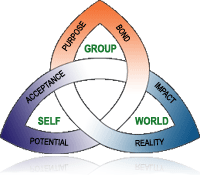 |
 |
01.20.10

What Your Group Needs to Become ExtraordinaryWhy do most groups fall short of their potential and only a few groups become extraordinary? To find out Geoffrey Bellman and Kathleen Ryan say we need to dig deeper into the wants, needs and motives that cause people to work together. They define an extraordinary group as one that “achieves outstanding results while members experience a profound shift in how they see their world.” They exhibit:

To accomplish this, you want to be a facilitative leader as opposed to a directive leader. With the group needs model in mind, the authors suggest that you “stand back from your group to consider the individual members, their collective purpose, and the world in which they operate” and ask “How might this group experience meet those needs?” Then consider the eight indicators of extraordinary groups (listed above) to see if they are present. Do members of the group seem energized, hopeful, connected and positively changed? A group leader needs to frame an inspiring purpose, lead with a light touch, keep the issues discussable, manage the world around the group acting as a buffer and facilitator, make sure the right people are on the team (those people with the knowledge, skills, or experience to tackle the group’s purpose), and integrate the Groups Model into their approach. Ask yourself questions like: “How will this meeting meet the needs of acceptance and potential, bond and purpose, reality and impact?” “Where and how can we use our differences as a group strength?” “Is there enough room in the agenda so that members have time for those more in-depth and sometimes complex conversations?” Extraordinary Groups offers practical advice on implementing the Groups Model into your own group situation. All of the suggestions offered are accompanied by examples, reflection questions and sample actions for both you and the group. By paying attention to group needs you can more consistently transform ordinary groups into something more energizing, connecting and affirming.
Posted by Michael McKinney at 12:02 AM
|
BUILD YOUR KNOWLEDGE
 

How to Do Your Start-Up Right STRAIGHT TALK FOR START-UPS 
Grow Your Leadership Skills NEW AND UPCOMING LEADERSHIP BOOKS 
Leadership Minute BITE-SIZE CONCEPTS YOU CAN CHEW ON 
Classic Leadership Books BOOKS TO READ BEFORE YOU LEAD |